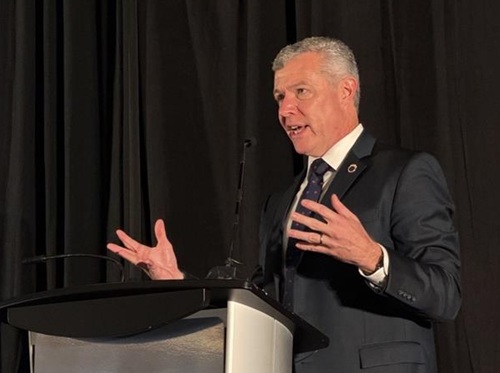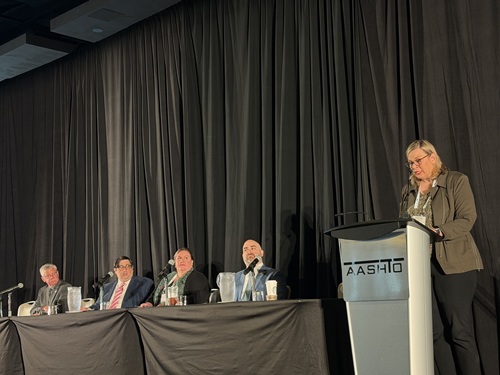Several state departments of transportation got a head start on efforts to support the 2023 National Work Zone Awareness Week or NWZAW campaign by initiating their own state-level work zone safety efforts.
[Above photo by Work Zone Safety]
For example, as part of their respective preparations for the national 2023 NWZAW effort, the Oklahoma Department of Transportation and Oklahoma Turnpike Authority launched a statewide effort on April 3 called “Make it Home Safe; Make Oklahoma Safe” to encourage motorists to follow a few simple rules of the road such as buckling up, putting away distractions and slowing down inside work zones to help get everyone home safe each day when traveling.

Tim Gatz, secretary of the Oklahoma DOT and executive director of the OTA, said motorists should expect to see more work zones pop up this spring and summer. In fact, drivers can expect more than 160 active work zones in Oklahoma this summer driving season, ranging from short-term maintenance projects with minimal impact to traffic to major interstate reconstruction, which can affect more than 100,000 vehicles per day.
“We have some significant projects starting in both Oklahoma City and Tulsa metro areas as well as several impactful construction work zones across the state this summer,” he explained in a statement. “We work hard at keeping work zones safe for motorists and workers but we cannot do it without motorists’ help. We emphatically plead with the public to be our safety partners by paying attention, slowing down and making sure all occupants of a vehicle are buckled up.”

[Editor’s note: The annual NWZAW campaign, held every spring to coincide with the start of construction season, encourages safe driving through highway work zones. Click here to learn more about the 2023 NWZAW campaign and the campaign kick-off event that Missouri Department of Transportation will host. And click here to learn about the recent joint bipartisan resolution issued to recognize April 17 through April 21 as “National Work Zone Awareness Week” for 2023.]
As part of that state-level effort, personnel with the Oklahoma DOT, the Work Zone Safe program, and its safety partners walked Oklahoma students through a mock work zone on April 7 to educate them about hazards they may face on highways when driving. Following a few simple rules of the road such as buckling up, putting away distractions and slowing down inside work zones could mean the difference between a life-altering crash and getting home safely.

“The premise behind Work Zone Safe is to give teen drivers the information they need to navigate highway work zones before they ever encounter one on the road,” said Tom Robins, the founder of Work Zone Safe, in a statement. “We want teens to know the rules of the road to help ensure they and our workers arrive home safe every day.”
[Editor’s note: A recent blog post by the Transportation Research Board re-emphasized that “much more work” needs to be done in terms of detailed research, planning, and technology usage to make highway work zones safer for construction personnel and motorists alike.]
Meanwhile, the North Carolina Department of Transportation participated in North Carolina Work Zone Awareness Week, held April 3 through 7, to remind state residents that speeding and distracted driving are the leading contributors in over half of all work zone crashes.

“Work zones often feature obstacles and people working within a few feet of passing traffic,” noted N.C. State Highway Patrol Col. Freddy Johnson in a statement.
“Slow down and pay attention to driving. You don’t have the same time to react in a work zone that you do on the open road and being careless could be deadly for you, your family members or others,” he said.
A variety of technologies are also being deployed in an effort to improve work zone safety.
For instance, a recent study completed by the University of Missouri found that using a self-driving truck to follow a crewed vehicle has the potential to reduce worker injuries in highway work zones. Henry Brown, a research engineer in the school’s civil and environmental engineering department, presented the study’s findings to the Missouri Department of Transportation.

In a blog post, Brown noted that so-called “moving work zones” on highways – operations that include activities such as pavement striping – typically involve a series of vehicles, with the last truck at most risk of being in a wreck. He added that MoDOT uses truck-mounted “crash cushions,” known as truck mounted attenuators or TMAs, positioned at the end of mobile work zones to absorb the impact of a potential crash.
The University of Missouri’s study found, though, if the vehicle equipped with the TMA is a self-driving truck, more injuries could be avoided.
“We want to eliminate worker injury by getting the driver out of the last vehicle,” Brown said. “The idea is you pair the last two vehicles as a leader and a follower retrofitted with kits that allow the second vehicle to follow GPS [global position satellite data] crumbs from the vehicle in front of it.”

[Editor’s note: The Colorado Department of Transportation is using a recent federal grant to conduct further study of autonomous TMAs to further work zone safety for its personnel.]
Concurrently, two field studies conducted by the AAA Foundation for Traffic Safety examined the effectiveness of certain “countermeasures” that aim to reduce highway work zone crashes – especially vehicle-mounted electronic variable message signs or VMSs.
The Foundation’s field work found those vehicle-mounted electronic VMSs proved “very effective” in preventing highway work zone crashes. In fact, with VMS activated, drivers changed lanes and slowed down more than when the VMS was not operating – with the odds of a vehicle “moving over” 95 percent higher with VMSs in use, the group noted.
 Top Stories
Top Stories
Collaboration Touted at AASHTO’s Third Safety Summit
October 31, 2025 Top Stories
Top Stories

